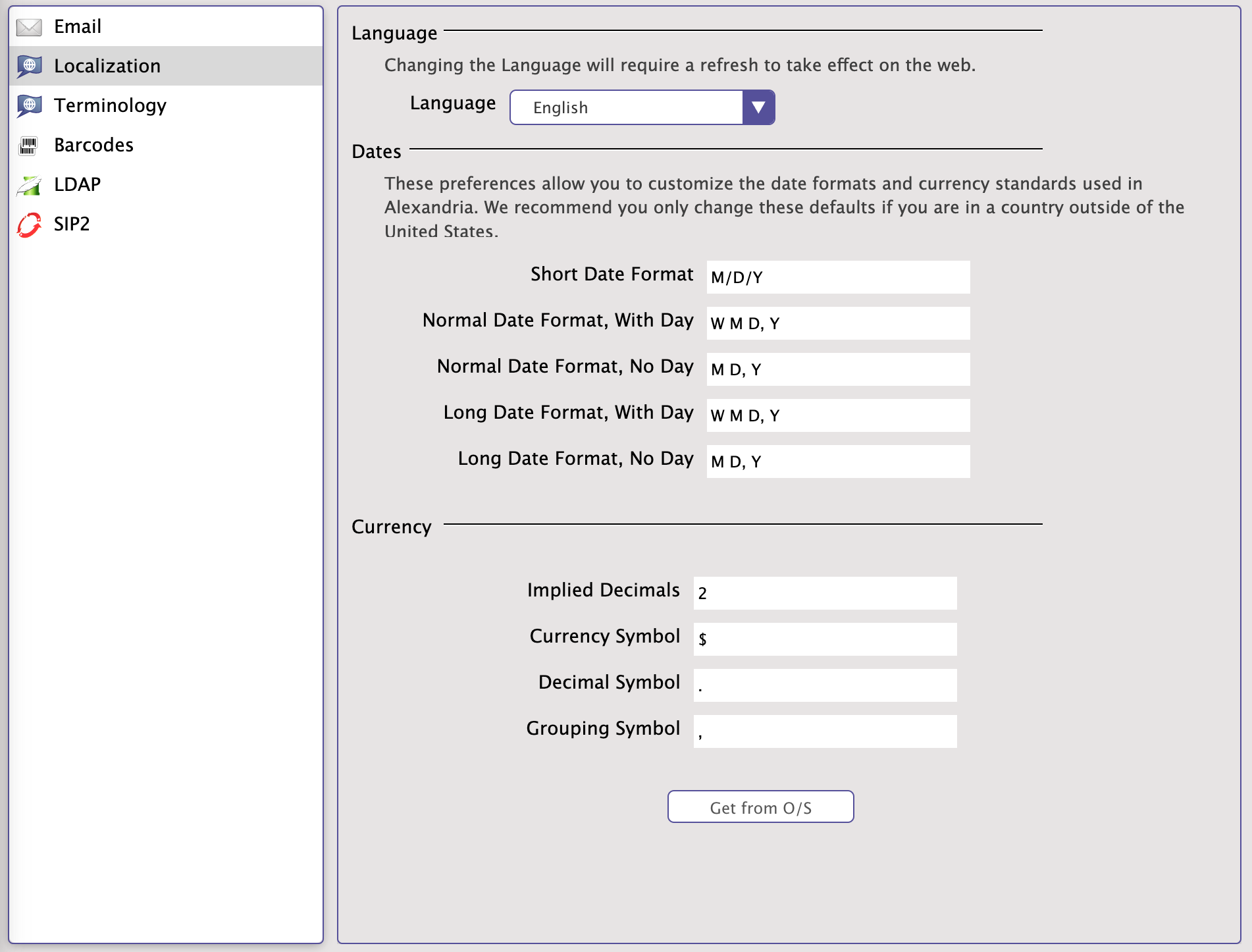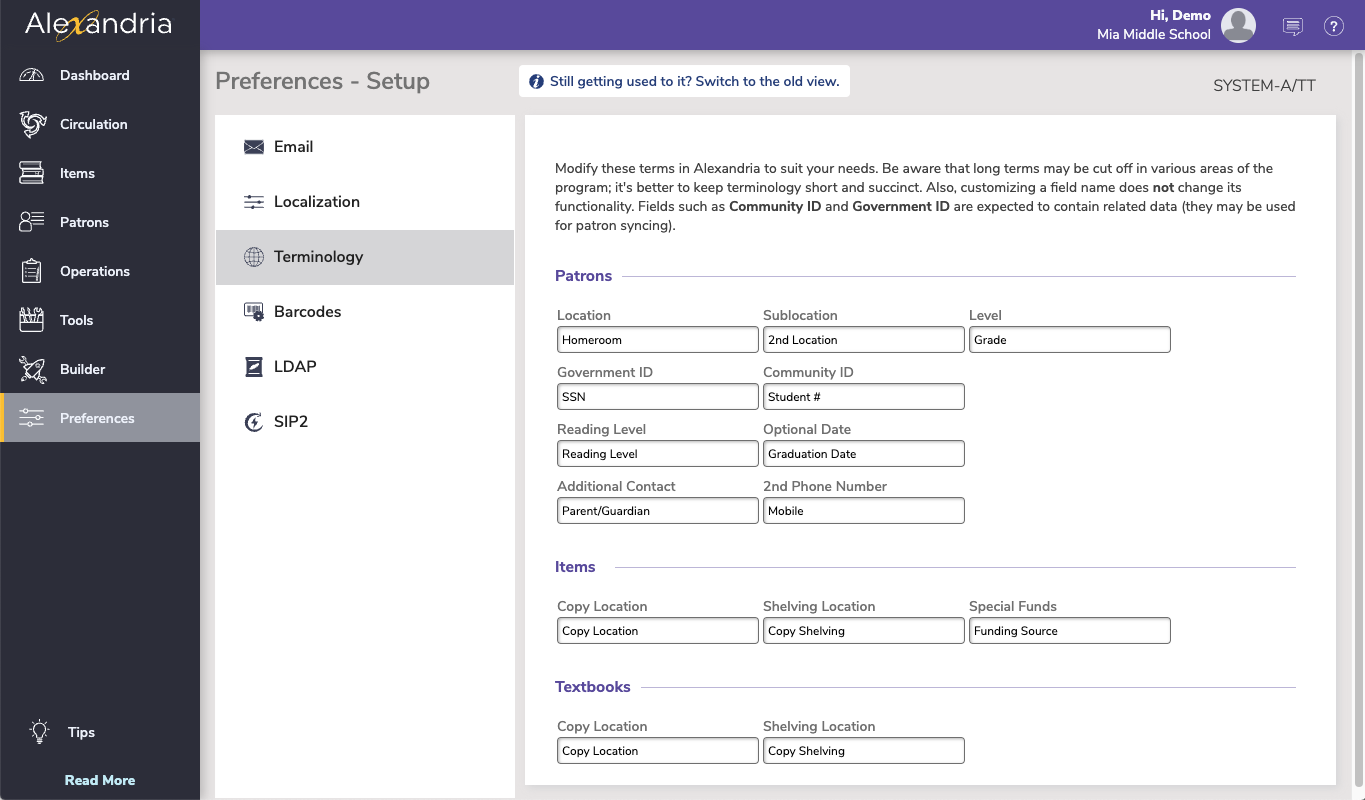How helpful was this page?
Related Blog Posts
Blog Posts
-
Winter storms–recompute due dates
created by
Jan 23, 2024
-
Cleaning up the grade table–Authority Control
created by
Apr 26, 2023
-
Make a calendar just for the senior class!
created by
Aug 02, 2022
-
When does an overdue item become lost?
created by
Mar 15, 2022
-
Setting rules–Patron Policy Preferences
created by
Mar 08, 2022
-
Seeing double (barcodes) on patrons and items?
created by
Feb 23, 2022
-
Automatic email notices... What are you waiting for?
created by
Nov 17, 2021
-
Winter (break) is coming! Are your period due dates set?
created by
Oct 20, 2021
-
Unused Barcodes: Reporting for Duty
created by
Sep 15, 2021
-
Introducing... FAQs!
created by
Jul 07, 2021
Preferences > Setup > Localization
SYSTEM Preference
These preferences allow you to have complete customization over language, date formats, and currency standards. You should only ever need to configure the Dates and Currency preferences if you are in a country outside of the United States; changes made to these preferences will take effect immediately.
In the United States of America, date formats are typically expressed in month, day, year order; however, aside from Belize[1], the vast majority of the world expresses dates in the ascending order of day, month, year. These two formats are largely incompatible and can cause massive date confusion. For example, in the United States, 03/07/16 generally means it is the 7th of March, 2016—in the rest of the world, it means it is the 3rd of July, 2016. Changing Dates settings will affect all circulation computations (e.g. reservations and holds) and nearly every date format displayed throughout Alexandria, including those found in Reports, Policies (e.g. hard due dates), notifications, etc.
Language
This preference allows you to set Alexandria to operate in your default language. Changing the default language requires a browser refresh to take effect.
Alexandria cannot catalog or display languages with alphabets containing non-Roman characters (e.g. Arabic, Chinese, Japanese, Korean, Russian, etc.). However, non-Roman languages that have been “translated” to Roman (Latin) can be saved. For example, the Arabic language book “كتاب ألف ليلة وليلة” could be translated to “One Thousand and One Nights” and then successfully cataloged in Alexandria.
The default language preference is initially set by your Alexandria registration information.
- English. This selection will make English the default language for Alexandria.
- Español. Esta selección hará Español el idioma predeterminado de Alexandria.
Dates
- Short Date Format. Some of Alexandria's date-based commands will only be accepted if they follow the format you specify here. Use a forward slash (/), dash (-), or comma (,) to parse the date.
- M/D/Y = 02/27/2018
- D/M/Y = 27/02/2018
- Normal Date Format, With Day
- W M D, Y = Fri. May 11, 2018
- W D M, Y = Fri. 11 May, 2018
- Normal Date Format, No Day
- D M, Y = 27 Feb, 2018
- M D, Y = Feb 27, 2018
- Long Date Format, With Day
- W M D, Y = Tuesday Feb 27, 2018
- W D M, Y = Tuesday 27 Feb, 2018
- Long Date Format, No Day
- D M, Y = 27 Feb, 2018
- M D, Y = Feb 27, 2018
Currency
- Implied Decimals. This value, which must be between 0 and 4, determines how many implied decimals (numbers after the decimal point) are used for your local currency standards. For example, 2 is correct for United States currency.
- Currency Symbol. Only single-character currency symbols are supported, such as $, ¤, ¢, €, or ₤.
- Decimal Symbol. Specify the symbol used as the decimal point (e.g. as in “.” for United States currency).
- Grouping Symbol. Specify the symbol used as the grouping separator (e.g. as in “,” for thousands in United States currency). Currently, only 3-digit groupings are supported.
- Get from O/S. Pressing this button will automatically import localized currency settings from your Data Station's operating system.
Terminology Preferences
SYSTEM-A/TT
This page has been moved over to https://support.goalexandria.com/preferences/setup-preferences/terminology/
\These preferences are used to customize terminology for some of the patron- and item-related fields within Alexandria, including those commonly found in the Patrons and Items management windows. Long terms may be cut off in various areas of the program; therefore, it is always best to keep terminology short and succinct. Changes made to these preferences will take effect immediately.
If numeric ranges are going to be used with any of these fields, they need to be padded with zeros in order to be sorted and selected correctly. For example, instead of a “1”, “2”, “402”, you’d insert “001”, “027”, “402”. Basically, in order to sort properly, all entries with a numeric range need to have the same number of characters.
Keep in mind that customizing a field name does not change its core functionality; fields such as Community ID, Government ID, and Login Name are still expected to contain correlating data.
Patrons
- Location. This preference allows you customize the term used for the Location field. For school libraries, this defaults to Homeroom; for other sites, this term defaults to Location. Although you may change this terminology, our documentation generally refers to it as Location.
- Sublocation. This preference allows you customize the term used for the Sublocation field. Use this field for whatever extra information you may need to enter. For example, you may want to use the term “Last Period” to identify an alternate location below the primary Location field. Although you may change the term, our documentation generally refers to it as 2nd Location.
- Level. This preference allows you customize the term used for the Level field. For school libraries, this defaults to Grade; for other sites, this term defaults to Level. Although you may change the term, our documentation generally refers to it as Grade.
- Government ID. This preference allows you customize the term used for national identification numbers; in the United States, this is typically the Social Security Number. Although you may change the term, our documentation generally refers to it as SSN.
- Community ID. This preference allows you customize the term used for community or local identifiers. For school libraries, this defaults to Student #; for other sites, this term defaults to ID #. Although you may change the term, our documentation generally refers to it as Student #.
- Reading Level. This preference allows you customize the term used for the leveled reading system(s) utilized at your school (e.g. Fountas and Pinnell or Accelerated Reader). Although you may change the term, our documentation generally refers to it as Reading Level. If your school, site, or institution doesn’t use the reading level terminology, this field can be used for other info such as AUP (acceptable usage policy) status.
- Additional Contact. This preference allows you customize the term used for emergency or secondary contacts. Although you may change the term, our documentation generally refers to it as Parent/Guardian.
- Optional Date. This preference allows you customize the term used for a patron record's optional date field. Although you may change the term, our documentation generally refers to it as Graduation Date.
- 2nd Phone Number. This preference allows you customize the term used for the secondary phone number field. Although you may change the term, our documentation generally refers to it as Mobile.
Items
- Copy Location. This preference allows you customize the term used for the Copy Location field stored in the 852_b tag. For example, you may want to use the term “Collection” or “Library Floor” (for a multi-leveled library) rather than “Copy Location”. Although you may change this terminology, our documentation will generally refer to it as Copy Location.
- Shelving Location. This preference allows you customize the term used for shelving location, an alternative location field stored in the 852_c tag. Although you may change this terminology, our documentation will generally refer to it as Copy Shelving.
- Special Funds. This preference allows you customize the term used for government grants or special funding stored in the 852_1 repeating tag. Although you may change this terminology, our documentation will generally refer to it as Funding Source.
Textbooks
- Copy Location. This preference allows you customize the term used for the Copy Location field stored in the 852_b tag. For example, you may want to use the term “Collection” or “Library Floor” (for a multi-leveled library) rather than “Copy Location”. Although you may change this terminology, our documentation will generally refer to it as Copy Location.
- Shelving Location. This preference allows you customize the term used for shelving location, an alternative location field stored in the 852_c tag. Although you may change this terminology, our documentation will generally refer to it as Copy Shelving.



